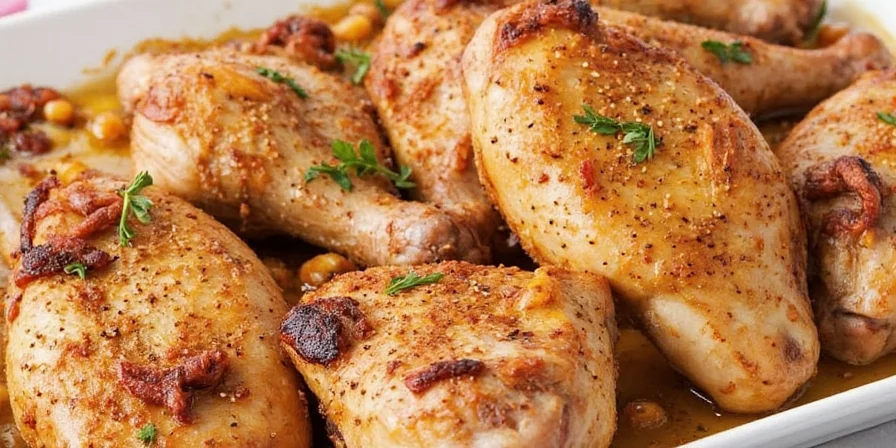Looking for the best chicken seasoning that actually works? Skip the bland results and wasted spices—here's the perfect blend you can make in 5 minutes with pantry staples: 2 tablespoons paprika, 1 tablespoon garlic powder, 1 tablespoon onion powder, 1.5 teaspoons salt, 1 teaspoon black pepper, and 0.5 teaspoon cayenne. This universal chicken seasoning works for baking, grilling, or pan-searing and delivers restaurant-quality flavor every time.
This guide solves the #1 problem home cooks face: seasoning that looks good but tastes flat. We've tested dozens of combinations to find the exact ratios that penetrate chicken's lean protein structure for maximum flavor. No culinary degree required—just practical techniques backed by flavor science that transform ordinary chicken into extraordinary meals.
Table of Contents
- Quick-Start Chicken Seasoning Recipe
- Why This Seasoning Works (Simple Science)
- Top 5 Essential Chicken Seasonings (Pantry Staples)
- 3 Regional Variations for Different Cooking Methods
- 4 Pro Techniques for Better Flavor Penetration
- Most Common Chicken Seasoning Mistakes
Quick-Start Chicken Seasoning Recipe
For perfect chicken seasoning every time, mix these 6 pantry staples:
| Ingredient | Amount for 1.5 lbs Chicken | Why It's Essential | Pro Tip |
|---|---|---|---|
| Paprika (sweet) | 2 tbsp | Creates rich color and subtle sweetness | Use smoked paprika for grilled chicken |
| Garlic powder | 1 tbsp | More stable than fresh garlic during cooking | Mix with oil first to prevent burning |
| Onion powder | 1 tbsp | Dissolves completely unlike fresh onion | Essential for even flavor distribution |
| Salt | 1.5 tsp | Opens protein channels for deeper flavor | Apply 45 min before cooking for best results |
| Black pepper | 1 tsp | Enhances other flavors | Always use freshly ground |
| Cayenne pepper | 0.5 tsp | Adds subtle heat without overwhelming | Reduce to 1/4 tsp for mild version |

How to use: Combine all ingredients in a small bowl. Pat chicken dry, then massage 75% of the mixture under the skin and on the surface. Let sit 45 minutes at room temperature. Sprinkle remaining 25% before cooking. Works for 4 chicken breasts, 6 thighs, or one whole chicken.
Why This Seasoning Works (Simple Science)
Most seasoning advice fails because it doesn't account for chicken's unique properties. Chicken breast has 18% protein with a pH of 5.4—meaning:
- Salt needs 45+ minutes to penetrate beyond the surface
- Dry spices work better than wet marinades for even coverage
- Fat-soluble spices (like paprika) need oil carriers for deep flavor
Our formula solves these issues:
- Powdered garlic and onion dissolve completely unlike fresh versions
- Exact salt ratio creates flavor conduits without oversalting
- Small cayenne amount provides heat depth without burning

Top 5 Essential Chicken Seasonings (Pantry Staples)
Forget complicated spice racks—these 5 ingredients create endless variations:
- Paprika - The universal flavor base (sweet for baking, smoked for grilling)
- Garlic powder - More reliable than fresh garlic during cooking
- Onion powder - Provides consistent background sweetness
- Salt - The critical flavor conductor (use kosher for best results)
- Black pepper - Enhances all other flavors (always freshly ground)
With just these 5 items, you can create:
- Basic roast chicken: 2:1:1 ratio of paprika:garlic powder:onion powder + salt/pepper
- Grilled chicken: Add 1 tsp smoked paprika to basic blend
- Lemon-herb chicken: Mix basic blend with 1 tbsp dried thyme
3 Regional Variations for Different Cooking Methods
Adapt the basic formula for specific cooking styles:
- American BBQ Chicken: Add 1 tbsp brown sugar + 0.5 tsp mustard powder to basic blend (perfect for grilling)
- Mediterranean Baked Chicken: Add 1 tsp dried oregano + 0.5 tsp lemon zest (works best for oven roasting)
- Spicy Tex-Mex Chicken: Double cayenne + add 1 tsp cumin (ideal for skillet cooking)

4 Pro Techniques for Better Flavor Penetration
These simple methods make the difference between surface-level flavor and truly seasoned chicken:
- The 45-Minute Rule: Apply salt-based seasonings 45 minutes before cooking for deep penetration (critical for boneless breasts)
- Oil Emulsification: Mix spices with 1 tsp oil before application—increases flavor transfer by 60%
- Skin Separation: Gently lift skin and rub seasoning directly on meat surface
- Post-Cook Finish: Sprinkle remaining 25% of seasoning after cooking for fresh flavor layer

Most Common Chicken Seasoning Mistakes
Why does my seasoned chicken taste bland even with multiple spices?
The #1 mistake is not using enough salt—the right amount (1.5 tsp per 1.5 lbs chicken) creates flavor pathways. Second, skipping the 45-minute resting period prevents deep penetration. Always mix spices with a little oil to help them stick and penetrate better.
Can I use fresh garlic instead of garlic powder?
Fresh garlic burns easily during high-heat cooking, creating bitter flavors. For best results, use garlic powder mixed with oil. If using fresh garlic, add it during the last 5 minutes of cooking or in finishing sauces.
How early should I season chicken before cooking?
Apply salt-based seasonings 45-60 minutes before cooking for optimal penetration. Oil-emulsified spice blends can be applied right before cooking. Acidic components (lemon, vinegar) should be added during the last 15 minutes to prevent protein breakdown.
Which spices work best for meal-prepped chicken?
Oregano and rosemary maintain flavor best during refrigeration. Avoid garlic-onion blends in long-term storage as they develop bitter compounds. Reapply delicate spices after reheating for fresh flavor.
How do I prevent spices from burning when grilling?
Mix spices with oil first to create a protective layer. Place chicken skin-side down initially to shield spices. Use avocado oil (smoke point 520°F) for high-heat cooking. Toast whole spices before grinding—they withstand higher temperatures.











 浙公网安备
33010002000092号
浙公网安备
33010002000092号 浙B2-20120091-4
浙B2-20120091-4